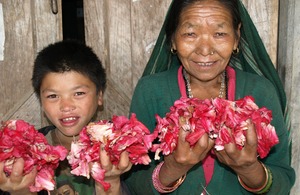A future for people and forests in Nepal
How UKaid from DFID is helping rural communities in Nepal adapt to the effects of climate change by better management of the forest and its resources

A woman and boy holidng Rhododendron flowers. Picture: Sibongile Pradhan/LFP/DFID
Video: Nepal Livelihoods Forestry Programme / Handcrafted Films / DFID*
Climate change is being felt in the forests of Nepal. Erratic rainfall, melting glaciers, flash floods and landslides, droughts, forest fires and dried-up springs are leading to reduced crop production, loss of land, increased pests and disease and food scarcity.
But people are finding ways to cope and adapt. Through expertise and funding from Nepal’s Livelihoods and Forestry Programme supported by the British Government through the Department for International Development, community groups who use the forest are becoming more resilient.
They are learning to manage the forest sustainably, which has stopped the landslides and reduced soil erosion. Barren land is being planted and new growth encouraged. They are using their funds to promote fuel-efficient stoves and alternative means of energy, reducing the need for firewood or fossil fuels. New ways are being found to generate income with forest-related enterprises that enhance all the forest users’ livelihoods.